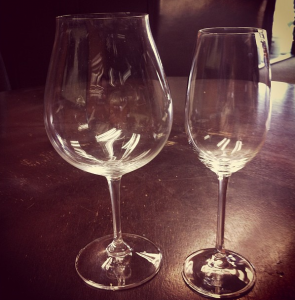People are naturally skeptical. So when presented with the idea that stemware not only makes a difference but can completely change your physical perception of a wine, most people raise an eyebrow.
And that’s okay.
We’re not trained to think that a glass matters. Plates don’t change the taste of food, do they? Is there a special spoon to make my ice cream taste better? Nope.
But we’re talking about the sense of smell and the sense of taste, and a plate or spoon are different because they are holders, not deliverers.
Here is the analogy to keep in mind: the wineglass is a delivery system for the sense of smell and taste, like a speaker delivering music to your ears. You can have a $300,000 Goldmund’s Reference II turntable hooked up to a Pivetta Opera One Amplifier (a steal at $490,000), and monster cables leading out to your speakers … but if you have cheap and low quality speakers you’re going to have horrible sound.
This isn’t voodoo or hocus-pocus. There is no three card monte game going on in front of you. This is science, pure and simple.
Two things are at work with proper stemware. First, the size and shape of the bowl controls and delivers the aromatic molecules that delivers the sense of smell. A big wine (Cabernet Sauvignon) swirled in a tight, small bowl will deliver a sharp, tart, and harsh aroma package. The same wine in a large bowl allows the expansion of the aromas to match the style of the wine. Second, the shape of the opening along with the thickness of the glass controls where on your tongue the wine gets delivered. Wherever it hits first makes the longest and strongest impression. Wines to emphasize fruit (ala Pinot Noir), should hit the tip of the tongue first. Wine to emphasize acid should hit farther back.
Nobody has done more research and development in this subject than the Riedel family. Through trial and error, testing and time, with the top winemakers and sommeliers in the world, they have developed the best stemware for the world of wines. A tasting with Georg or Max Riedel is one of the most eye-opening experiences a wine lover can have, and will leave you changed.
A good rule of thumb from Riedel is to spend the same amount on your stemware that you spend on an average bottle of wine. Do you drink $50 Pinot Noir regularly? Invest in a set of Vinum Burgundy glasses. Do you drink $10 Australian Shiraz all the time? Find a set of Overture Magnums. In other words, investing in quality stemware pays for itself over and over again by amplifying your hedonistic pleasure.
Here’s a fun video from Gary V, drinking Pinot Noir out of a half-dozen different stems. His honesty is apparent (and he announces he walked into this as a skeptic). Go straight to 16:20 to hear his conclusions.







